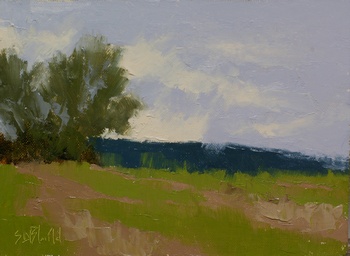
Short Hill Sketch. 6x8, oil on linen panel. 2015.
The most enjoyable paintings are those that can be painted with abandon. It's difficult to mess up a small sketch because anything wrong can be easily fixed (the tough part is admitting there is a problem). And since they require little time and effort, they can be discarded or set aside without too much regret when they can't be beaten into submission.
Small paintings have another major advantage: detail is useless. Although I admire painters who have the discipline to paint detailed miniatures, when working small I prefer to push paint around to create interesting shapes and edges, and let clumps of paint stand in for their real world counterparts. For example: a single stroke of paint is a tree, a patch of gray paint smeared with a painting knife is a cloud,
With that philosophy in mind a sketch like this takes about 30 minutes to complete. I mix all the paint first so I don't have to think about it when I stand over the canvas. Then I trowel on all the big shapes with a knife and gently work the edges with a large brush. I trowel on a bit more paint in places to modify the values and temperatures of the big shapes. Finally, I touch up some edges.
The most important lesson of all is that it is better to leave the entire painting under finished than to risk having any part of it over worked. As with all creative efforts, it takes a lot of practice to know when to stop.